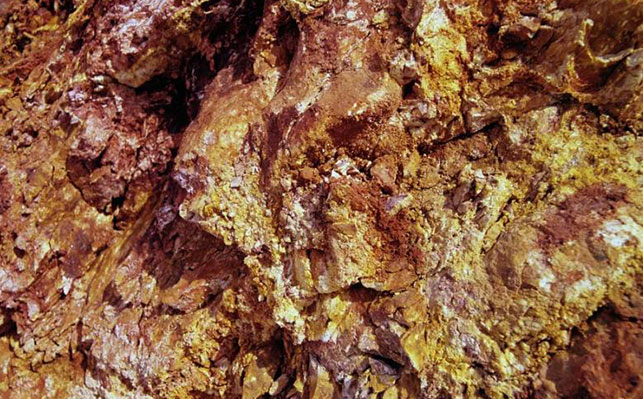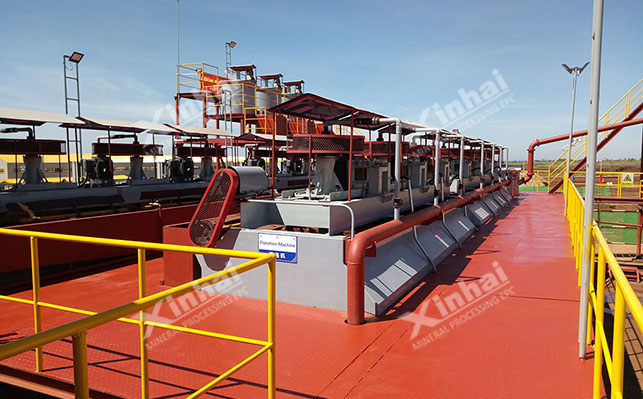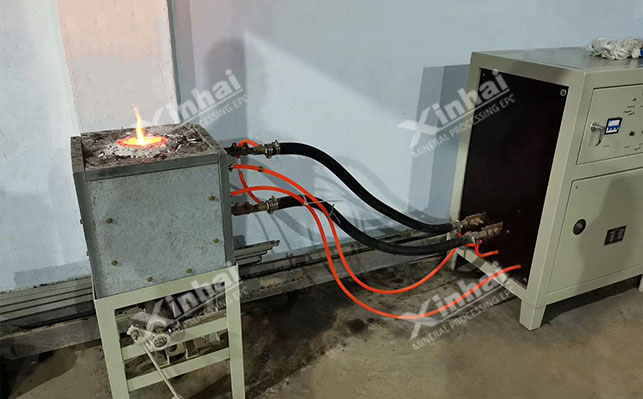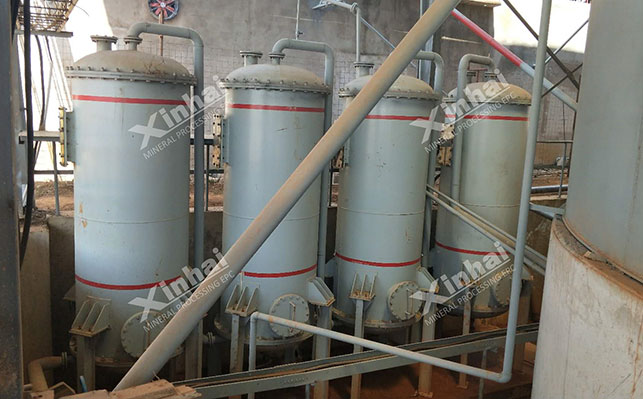
15311826613
Click to add WeChatGold refining is the process of extracting pure gold from gold-bearing ore or recycled materials. This process involves a series of complex physical and chemical operations, the main purpose of which is to separate gold from associated minerals and other impurities to obtain high-purity gold products. Depending on the source of the raw materials, the refining technology used is also different. This article will focus on gold refining, including what raw materials can be used to refine gold? What are the methods of gold refining? And what are the methods of gold concentrate? Three dimensions.

Primary gold ore refers to gold-bearing ore, such as quartz vein gold ore, placer gold ore, etc. Among them, the gold in quartz vein gold ore is present in various forms in the quartz vein deposit. In this type of ore, gold is often closely associated with quartz, distributed in fine or micro-granular form, and needs to be separated by processes such as crushing and grinding. Placer gold is formed by the enrichment of primary gold deposits in sedimentary environments such as rivers and beaches after weathering, erosion, and transportation. The gold particles in placer gold are usually in the state of natural gold, with relatively large particle size, and are mixed with loose sediments such as sand and gravel.
Placer gold deposits formed after natural weathering and transportation. Secondary gold ore is similar to placer gold ore and is also formed under natural action. Due to long-term weathering and transportation, gold particles re-aggregate in a new sedimentary environment to form a deposit with mining value. The gold content and particle size of secondary gold ore vary depending on geological conditions and sedimentary environments.
Recycled materials mainly include electronic waste, jewelry waste, industrial waste, etc. With the rapid replacement of electronic products, the amount of electronic waste generated is increasing, becoming an important source of gold recycling; the gold in circuit boards is mainly present in the pins of electronic components, connecting lines and the internal circuits of chips; jewelry waste usually refers to scraps and defective products generated during jewelry processing, or old jewelry discarded by consumers. The gold content in these wastes is relatively high, and most of them are in the form of pure gold or alloys, which are relatively easy to refine. In terms of industrial waste, some chemical, electroplating and other industries use gold in the production process, and the waste generated may contain residual gold. Through appropriate refining methods, resources can be recycled.
Before refining primary gold mines, pretreatment operations must be carried out first, mainly to crush large pieces of ore to form fine particles, usually requiring -200 mesh (i.e., particle diameter less than 0.074 mm) to account for about 60%-80%, to ensure that gold minerals are fully dissociated from other minerals, creating conditions for subsequent beneficiation and extraction operations. Then refining is carried out, and the main methods are gravity separation, flotation, cyanidation and smelting.

Gold gravity separation: using the high density of gold, gold particles are separated through shaking tables, chutes and other equipment. The shaking table uses the combined effect of the asymmetric reciprocating motion of the shaking table and the lateral water flow to separate the mineral particles on the bed according to density and particle size. A thin layer of slurry is spread on the inclined bed of the shaking table. When the shaking table reciprocates, the mineral particles are stratified and separated according to density and particle size under the flushing of the water flow and the friction of the bed surface. The gold particles with high density gradually move to the concentrate end of the bed surface, while the gangue minerals with low density are washed away by the water flow and become tailings; the chute beneficiation uses the difference in sedimentation speed of mineral particles of different densities under the action of water flow when the slurry flows in the inclined chute, thereby realizing the separation of gold particles and gangue.
Gold flotation: Chemical agents are used to make gold minerals adhere to bubbles and separate them from other minerals. Before flotation, the slurry after grinding is slurried to adjust the concentration and pH of the slurry. For most gold flotation, the pulp concentration is generally controlled between 20% and 40%, and the pH value is adjusted according to the properties of the ore and the requirements of the flotation reagent, usually between 7 and 11. In the flotation machine, under the action of stirring and aeration, the gold minerals adhere to the bubbles and float to the surface of the pulp with the bubbles to form a foam layer. The foam is scraped out by the foam scraping device to obtain a gold-containing foam product, that is, gold concentrate, and the tailings are left in the pulp.
Gold cyanidation: The gold ore is immersed in a sodium cyanide solution to dissolve the gold, and then the gold is extracted by activated carbon adsorption or zinc powder replacement. During the cyanide leaching process, the alkaline environment of the pulp must be ensured. Generally, lime is added to adjust the pH value of the pulp to between 10 and 12 to prevent the hydrolysis of sodium cyanide. Then, sodium cyanide solution is added to the pulp. Under aerobic conditions, gold reacts chemically with sodium cyanide to form a water-soluble gold-cyanide complex. After leaching is completed, activated carbon adsorption is used to recover gold from the leachate. Activated carbon is added to the leachate. After a certain period of stirring, the gold-cyanide complex is adsorbed on the surface of the activated carbon. Then, gold is recovered from the activated carbon through processes such as desorption and electrolysis. Another commonly used method is the zinc powder replacement method. Zinc powder is added to the leachate. Zinc and the gold-cyanide complex undergo a replacement reaction to replace gold from the solution to generate metallic gold and zinc-cyanide complexes. The replaced gold precipitate is separated by filtration and other methods to obtain gold mud, which is then smelted and other subsequent treatments to obtain crude gold.
Gold smelting: The extracted gold concentrate is subjected to high-temperature smelting to remove impurities and obtain crude gold. The smelting process is generally carried out in a furnace. Commonly used furnaces include reverberatory furnaces and electric arc furnaces. Before smelting, an appropriate amount of flux, such as borax and sodium carbonate, is usually added to the gold concentrate to reduce the melting point and promote the oxidation and separation of impurities. At high temperatures, the gold in the gold concentrate undergoes chemical reactions such as oxidation and reduction with other metals and impurities. The gold is reduced to a metallic state, while the impurities are discharged as slag or gas.

Electronic waste treatment:Gold is extracted by mechanical crushing, chemical leaching and other methods. First, the electronic waste is mechanically crushed to disassemble it into smaller parts, and then crushed into fine particles using crushers, pulverizers and other equipment for subsequent chemical leaching. The crushed electronic waste particles enter the chemical leaching process, and commonly used leaching agents include aqua regia, sulfuric acid-hydrogen peroxide system, thiourea solution, etc. During the leaching process, gold reacts chemically with aqua regia and dissolves in the solution to form a gold-containing solution. After leaching, the insoluble solid impurities are separated by filtration and other methods to obtain a solution containing gold ions, and then the gold is recovered from the solution by subsequent methods.
Chemical dissolution method:Use aqua regia (a mixture of hydrochloric acid and nitric acid) to dissolve gold, and then precipitate gold through a reducing agent (such as sodium sulfite). Put the gold-containing waste into an aqua regia container, and under appropriate temperature and stirring conditions, the
gold gradually dissolves in the aqua regia. After the dissolution is completed, the solution contains gold ions and other metal ions. In order to precipitate gold from the solution, a reducing agent needs to be added. Sodium sulfite is a commonly used reducing agent, which undergoes an oxidation-reduction reaction with gold ions, reducing the gold ions to metallic gold and precipitating them. During the precipitation process, the amount of reducing agent added and the reaction conditions must be controlled to ensure that the gold is precipitated completely and with high purity. The precipitated gold powder can be further smelted and purified after filtering, washing, drying and other treatments.
Electrolysis:The gold-containing material is used as the anode to extract pure gold by electrolysis. During the electrolysis process, the pretreated gold-containing material is made into an anode plate and placed in an electrolyte containing gold ions, usually a chloride solution containing gold. With a pure gold sheet as the cathode, after connecting to a DC power supply, under the action of the electric field, the gold on the anode loses electrons and dissolves into the solution to form gold ions, while the gold ions in the solution gain electrons on the cathode, are reduced to metallic gold and deposited on the cathode surface. As the electrolysis proceeds, the gold on the anode continues to dissolve, and the gold layer on the cathode gradually thickens. By controlling parameters such as electrolysis time, current density, and electrolyte temperature, the quality and purity of gold deposition can be guaranteed. After the electrolysis is completed, the deposited gold is stripped from the cathode, and after further refining, a high-purity gold product can be obtained.

High-purity gold is obtained by removing impurities through high-temperature smelting. Fire refining is generally carried out in a high-temperature furnace, such as a crucible furnace, an induction furnace, etc. The crude gold is placed in a furnace and heated to above the melting point of gold, which is generally 1064°C. At high temperatures, some low-melting-point impurities in the crude gold, such as lead and bismuth, will first melt and volatilize, while some high-melting-point impurities, such as copper and silver, will form alloys with gold. In order to further remove impurities, an appropriate amount of flux, such as borax, sodium carbonate, etc., can be added to the furnace. The flux reacts with the impurities to form slag, which floats on the surface of the metal liquid, and the slag is separated by skimming. At the same time, oxygen or air is introduced into the furnace to oxidize some easily oxidizable impurities such as copper and iron into oxides, which enter the slag or form gas to be discharged. After a period of smelting and refining, the purity of gold can reach 99% - 99.9%.
Use crude gold as anode and pure gold as cathode to purify by electrolysis. The equipment for electrolytic refining mainly consists of an electrolytic cell, an anode plate, a cathode plate and an electrolyte. The electrolyte usually uses a chloride solution containing gold, such as a gold chloride solution, and adds an appropriate amount of additives to improve the current efficiency and gold deposition quality during the electrolysis process. During the electrolysis process, the crude gold on the anode undergoes an oxidation reaction, and the gold atoms lose electrons and become gold ions that enter the solution. At the same time, some impurities in the crude gold, such as copper and silver, will also dissolve into the solution, but because their electrode potential is different from that of gold, the deposition order on the cathode is also different. Gold ions gain electrons at the cathode, are reduced to metallic gold and deposited on the cathode surface, while impurity ions remain in the solution or form anode mud and precipitate at the bottom of the electrolytic cell. By controlling electrolytic parameters such as current density, electrolyte temperature, circulation speed, etc., the purity of gold can be effectively improved. After electrolytic refining, the purity of gold can reach more than 99.99%.

Use chlorine or chloride to remove impurities and obtain high-purity gold of more than 99.99%. A common method of chemical refining is chlorination refining, which heats the crude gold to a molten state and then introduces chlorine. Chlorine reacts chemically with impurities in the crude gold, such as copper, silver, and lead, to generate corresponding chlorides. These chlorides have a low boiling point and will volatilize or form slag floating on the metal liquid surface at high temperatures, thereby separating from gold.
The above are methods for extracting and recovering gold from different channels. How to extract gold in an actual ore dressing plant? It is recommended to conduct ore dressing tests and design a suitable gold mining process plan through experimental analysis. Xinhai has rich experience in gold selection. It not only has traditional mineral processing technology, but also has made great breakthroughs in the research and development of new processes. At present, it has successfully developed 29 innovative gold selection processes. Xinhai will fully consider the characteristics of each ore and tailor a mineral processing plan for it.